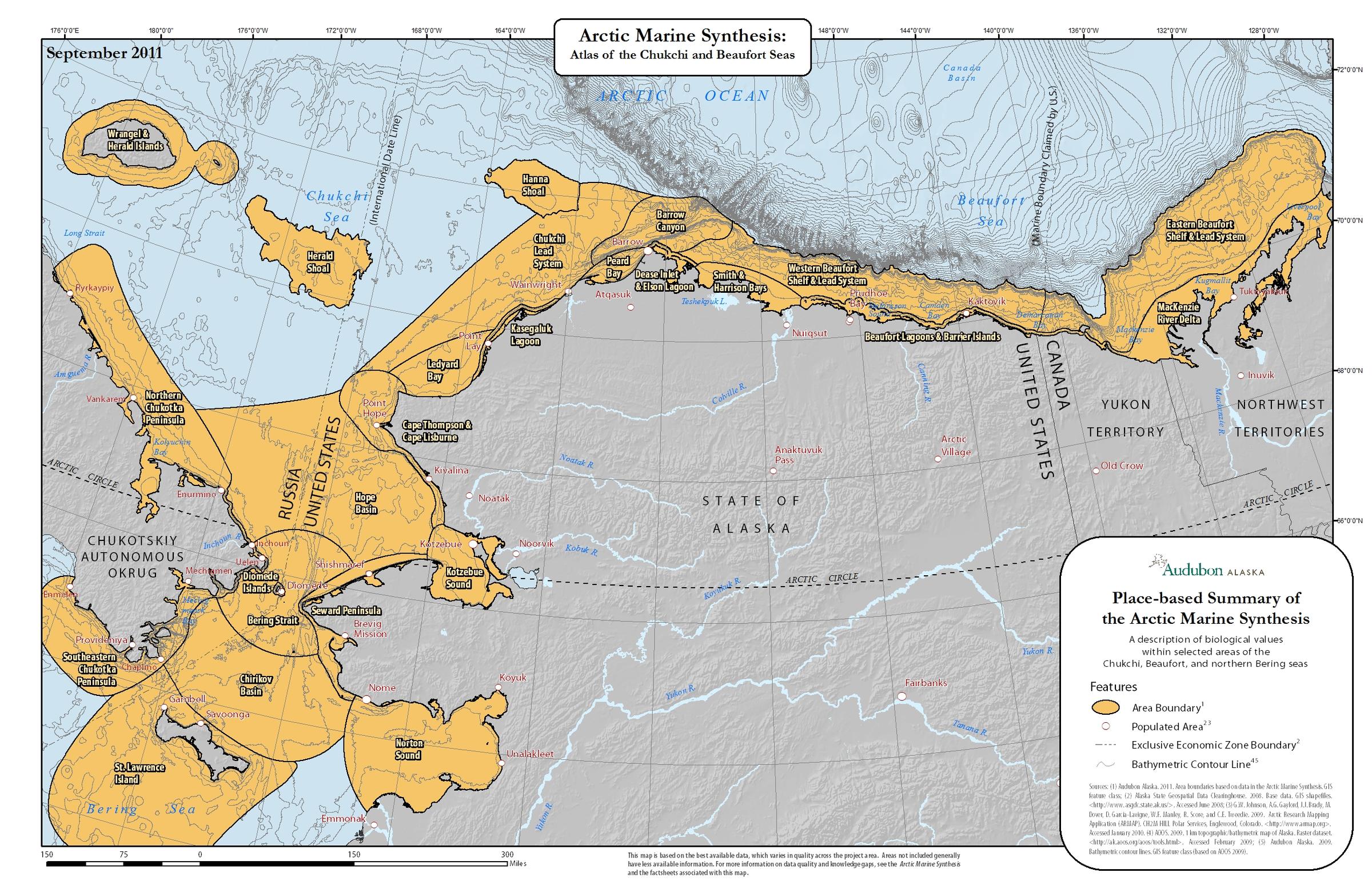Place-based Summary of the Arctic Marine Synthesis
This companion publication summarizes the Arctic Marine Synthesis for specific places. Want to know how many seabirds nest on islands in the Bering Strait? Or what time of year do bowhead whales migrate through Hope Basin? Take a tour of the Place-based Summary of the Arctic Marine Synthesis!
Arctic Marine Synthesis
In early 2010, Audubon Alaska, in cooperation with Oceana, completed the Arctic Marine Synthesis: Atlas of the Chukchi and Beaufort Seas. The project area includes the southern Beaufort, southern Chukchi, and northern Bering seas. The atlas provides a holistic look at the dynamic Arctic Ocean ecosystem. This collection of information will be an important tool for scientists and policymakers in setting conservation priorities and designing balanced management plans in this sensitive Arctic region.
The collection of 44 maps contains information on the physical environment, such as sea ice dynamics, the distribution of ice-dependent species including polar bears, and energy development and protected areas.
The recommended citation is Smith, M.A. 2010. Arctic Marine Synthesis: Atlas of the Chukchi and Beaufort Seas. Audubon Alaska and Oceana: Anchorage. Please contact Melanie Smith by phone (907-276-7034) or email with any questions or comments. This report is also available on CD and in a limited number of hard copies. Many thanks to the ESRI Conservation Program for their generous donation of ArcGIS software, which has been indispensable to Audubon Alaska’s conservation science program.
Below are links to the synthesis report and maps:
- Click on the SECTION HEADINGS, in capital letters, to link to the written narrative.
- The introduction describes the project’s purpose, our partnership with Oceana, the geospatial database, data quality, and knowledge gaps, and next steps.
- Each map description includes information on data compilation and mapping methods, data quality, and a summary of key habitats.
- The numbered entries link to individual maps.
PHYSICAL OCEANOGRAPHY
1. Project Area
2. Bathymetry
3. Ecoregions
4. Ocean Circulation
5. Sea Ice Dynamics
6. Sea Floor Substrate
7. Sea Surface Temperature
8. Observed Climate Change
WATER COLUMN AND BENTHIC LIFE
9. Chlorophyll-a
10. Net Primary Productivity
11. Zooplankton
12. Benthic Biomass
13. Opilio Crab
FISH
Oceanodromous
14. Capelin
15. Pacific Herring
16. Saffron Cod
Anadromous
17. Pink Salmon
18. Chum Salmon
BIRDS
Audubon Alaska WatchList
19. Yellow-billed Loon
20. Red-throated Loon
21. Spectacled Eider
22. Steller’s Eider
23. King Eider
24. Common Eider
25. Long-tailed Duck
26. Ivory Gull
27. Kittlitz’s Murrelet
Other Species
28. Northern Fulmar
29. Short-tailed Shearwater
Concentration Areas
30. Seabird Colonies
31. Important Bird Areas
MAMMALS
Terrestrial/Marine
32. Polar Bear
33. Arctic Fox
Pinnipeds
34. Pacific Walrus
35. Ribbon Seal
36. Spotted Seal
37. Ringed Seal
38. Bearded Seal
Cetaceans
39. Bowhead Whale
40. Beluga Whale
41. Gray Whale
PEOPLE
42. Energy Development and Protected Areas
43. Human Impact
44. Predicted Climate Change
How you can help, right now
Donate to Audubon
Help secure the future for birds at risk from climate change, habitat loss and other threats. Your support will power our science, education, advocacy and on-the-ground conservation efforts.
1% for the Planet
We are proud to be part of the 1% for the Planet network. If you own a business, please consider joining 1% for the Planet to support Audubon Alaska’s conservation efforts.





